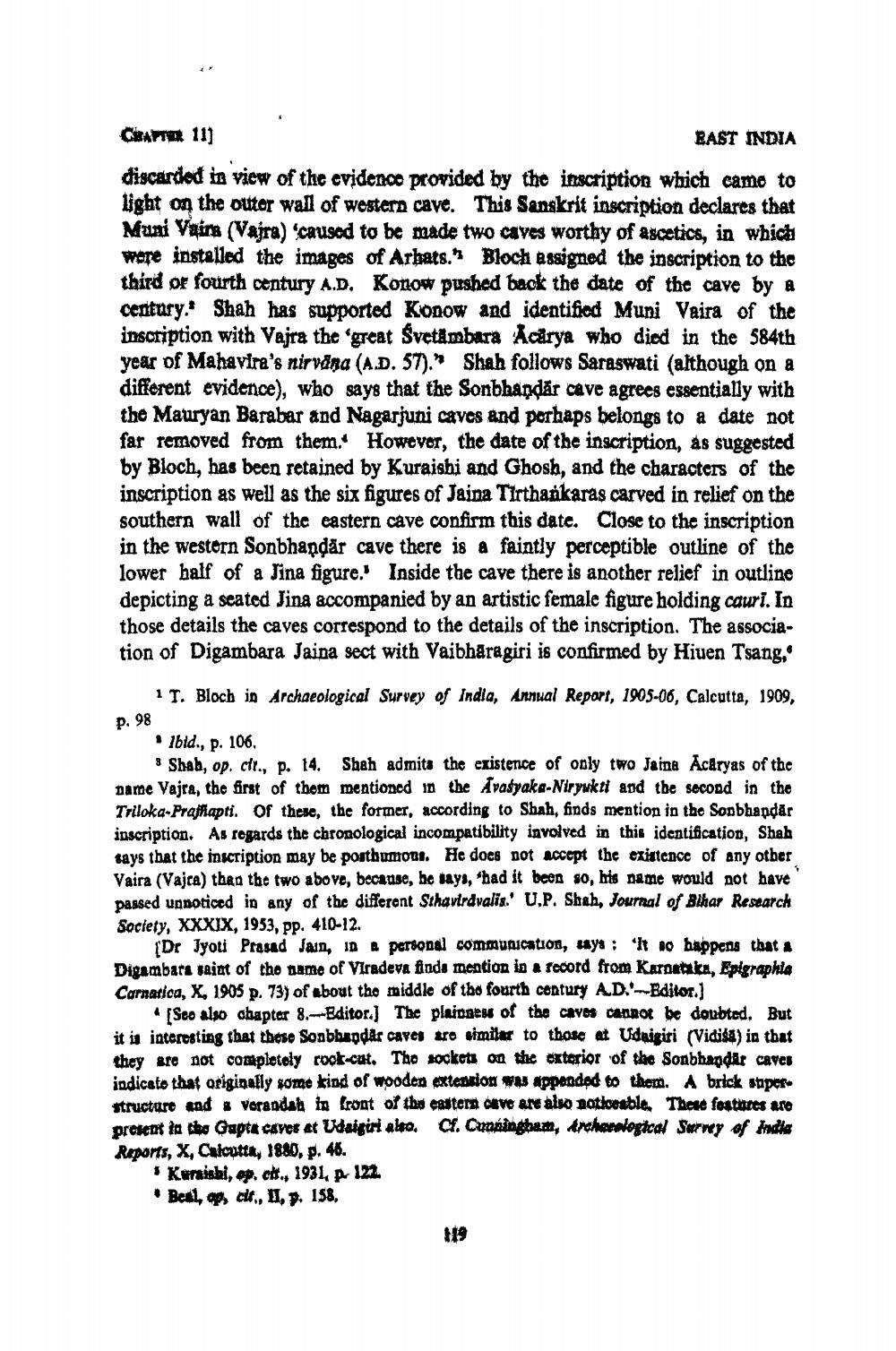________________
CHAPTER 111
EAST INDIA discarded in view of the evidence provided by the inscription which came to light on the outer wall of western cave. This Sanskrit inscription declares that Muai Vairs (Vajra) causod to be made two caves worthy of ascetics, in which were installed the images of Arhats. Bloch assigned the inscription to the third or fourth century A.D. Konow pushed back the date of the cave by a century. Shah has supported Konow and identified Muni Vaira of the inscription with Vajra the great Svetambara Acarya who died in the 584th year of Mahavira's nirvana (A.D. 57)." Shah follows Saraswati (although on a different evidence), who says that the Sonbhandár cave agrees essentially with the Mauryan Barabar and Nagarjuni caves and perhaps belongs to a date not far removed from them. However, the date of the inscription, as suggested by Bloch, has been retained by Kuraishi and Ghosh, and the characters of the inscription as well as the six figures of Jaina Tirthankaras carved in relief on the southern wall of the eastern cave confirm this date. Close to the inscription in the western Sonbhandar cave there is a faintly perceptible outline of the lower half of a Jina figure.' Inside the cave there is another relief in outline depicting a seated Jina accompanied by an artistic female figure holding cauri. In those details the caves correspond to the details of the inscription. The association of Digambara Jaina sect with Vaibharagiri is confirmed by Hiuen Tsang,
11. Bloch in Archaeological Survey of India, Annual Report, 1905-06, Calcutta, 1909,
p. 98
Ibid., p. 106,
Shah, op. cir., p. 14. Shah admits the existence of only two Jaina Acaryas of the Dame Vajra, the first of them mentioned in the Avasyaka-Niryukti and the second in the Triloka-Praffiapti. or there, the former, according to Shah, finds mention in the Sonbhandar inscription. As regards the chronological incompatibility involved in this identification, Shah says that the inscription may be posthumous. He does not accept the existence of any other Vaira (Vajca) then the two above, because, he says, 'had it been so, his name would not have passed unnoticed in any of the different Sthavirdvalis.' U.P. Shah, Journal of Bihar Research Society, XXXIX, 1953, pp. 410-12.
[Dr Jyoti Prasad Jain, 10 personal communication, says : It no happens that a Digambarı saint of the name of Viradeva finds mention in a record from Karnataka, Epigraphia Carnatica, X, 1905 p. 73) of about the middle of the fourth century AD. Editor.
Seo also chapter 8.-Bditor.) The plaiones of the caves cannot be doubted. But it is interesting that these Sonbhandar caves are similar to those at Udaigiri (Vidiša) in that they are not completely rook-cut. Tho sockets on the exterior of the Sonbhandar caves indicate that originally some kind of wooden extension was appended to them. A brick superstructure and verandah ta tront of the eastern Cave an also aatiootbleThese fostures are present in the Gapte caves At Vidalgui ało. .Cunaingham, Archanalogical Survey of India Reports, X, Cutoutta, 1880, p. 46.
* Kuraishi, op. okt., 1934, p In
Beel, y, ale, 1, 158,




